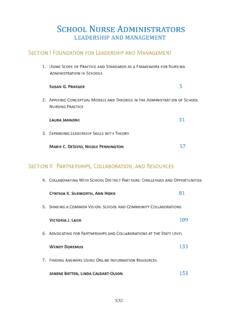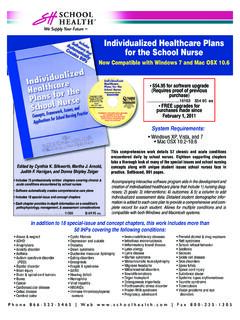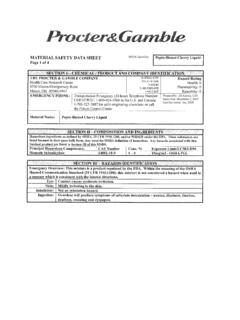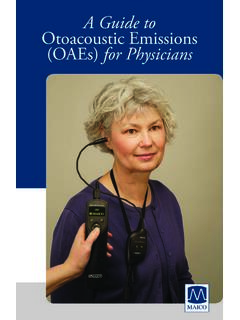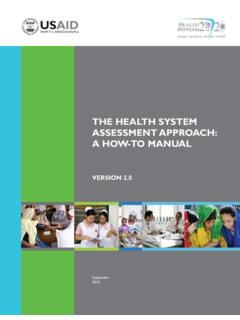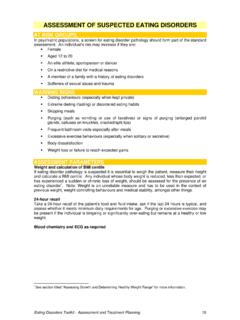Transcription of Oral and Written Language Scales, Second ... - School Health
1 oral and Written Language Scales, Second Edition (OWLS-II). Elizabeth Carrow-Woolfolk, Copyright 2011 by WPS. All rights reserved. Version WPS Scoring Summary As with any assessment tool, no final diagnostic or treatment decisions should be made solely on the basis of the OWLS-II without confirming information from independent sources. This scoring document for the OWLS-II should not be used on its own, but is designed to be integrated with other information about the individual, including background information, previous test data, and observations. The resulting interpretation can aid in diagnosis, treatment planning, and communication with parents and other professionals. The user should be familiar with the material presented in the OWLS-II Manuals (WPS Product No.)
2 W-603M, W-604M). Examinee Name: Christopher Gomez Examinee ID: 000110052 Administration Date: 08/08/11. Age: 9 years 2 months Processing Date: 08/08/11. Gender: Male Grade: 3. Ethnicity: Hispanic/Latino Term: Not Entered Standard English Dialect: Yes Setting: School Examiner Name/ID: Kathy Sinclair Form Type: A. Normative Reference Group: Age The oral and Written Language Scales, Second Edition (OWLS-II) is an assessment of receptive and expressive Language for children and young adults. The OWLS-II consists of four co-normed scales: Listening Comprehension (LC), oral Expression (OE), Reading Comprehension (RC), and Written Expression (WE). The following are presented for Christopher: - Scores for the scales that were administered - Graphical representation of scale standard scores - Normative comparisons for each scale - Discussion of differences between scales - Composite scores derived from the scales that were administered - Information regarding types of errors made on each scale scale scores scale Raw Standard Confidence Description Percentile Test-age score score interval rank equivalent 95%.
3 Listening Comprehension 93 105 100-110 Average 63 9 11. oral Expression 42 67 61-73 Deficient 1 5 11. Reading Comprehension 37 82 78-86 Below Average 12 7 4. Written Expression 50 68 62-74 Deficient 2 6 7. Note: The derived mean standard score for this test is 100, with a standard deviation of 15. A standard score of one standard deviation below or above the mean is considered to be within average limits. OWLS-II Scoring Summary Examinee ID: 000110052 Page: 2. Standard OWLS-II. score Percentile 160 > 150 140 130 98. 120 91. 110 75. 100 50. 90 25. 80 9. 70 2. 60 50 < 40. Listening oral Reading Written Comprehension Expression Comprehension Expression Standard score ranges: <70 Deficient; 70-84 Below Average; 85-115 Average; 116-130 Above Average; >130 Exceptional.
4 Normative comparisons for each scale Christopher's raw score on each scale is compared with the scores of other individuals of the same age from the normative sample. These normative comparisons provide the basis for the standard scores that are the primary means of score interpretation. Across all scales, the linguistic structures that are measured vary by age. Individuals aged 6 to 10 years are measured on their knowledge of vocabulary (semantics), including basic substantive words classified as nouns, verbs, adjectives, and adverbs. They are also tested on higher level vocabulary and idioms. These individuals are also assessed on grammatical morphemes, including function words such as determiners, conjunctions, auxiliaries, and pronouns, and on inflections such as noun/verb agreement, verb tense, and noun plurality.
5 Sentence structures, such as negative and interrogative types and compound and basic complex sentences, are also assessed. Individuals in this age range are also tested on pragmatic skills. Performance on the oral tests: LC and OE. Listening Comprehension. This scale measures oral Language reception, which is the understanding of spoken Language . The examiner orally presents increasingly difficult words, phrases, and sentences to Christopher and he responds by pointing to or stating which of four pictures is correct. Christopher's score of 105 falls within the Average range compared with the standardization population of individuals at his age level. Using percentile scores for interpretation of Christopher's performance, the Listening Comprehension scale score corresponds to a percentile rank of 63, meaning that 63% of the individuals his age in the standardization population scored the same as or below Christopher in the ability to comprehend the meaning of oral Language structure.
6 OWLS-II Scoring Summary Examinee ID: 000110052 Page: 3. oral Expression. This scale measures oral Language expression, which is the use of spoken Language . The examiner presents a verbal prompt along with a picture and Christopher must respond orally to the prompt with increasingly difficult Language . On the oral Expression scale , Christopher's standard score of 67 is within the Deficient range. The score on the oral Expression scale corresponds to a percentile rank of 1; this means that 1% of the individuals his age in the standardization sample scored the same as or below Christopher in the expression of oral Language . This performance is at or below two standard deviations below the mean, which means that the majority of individuals scored higher than Christopher.
7 This suggests the possibility of a Language disorder or deficit compared with others his age. When presented with a score at this level, it is important to recognize that such a low score may indicate a disorder in this area, but it is also necessary to determine other factors that can contribute to a low score, such as motivation, cognitive limitations, and so on. Some items on the oral Expression scale include a distinction between preferred and acceptable for the correct responses. Christopher gave 2 preferred responses and 11 acceptable responses for the items administered. Performance on the Written tests: RC and WE. Reading Comprehension. This scale measures the comprehension of Written Language .
8 Christopher is presented with Written words, phrases, sentences, or paragraphs and responds by pointing to or stating which of four options is correct. Pictures are used on some of the earlier items. On the Reading Comprehension scale , Christopher's standard score of 82 falls within the Below Average range compared to other individuals his age. This corresponds to a percentile rank of 12, which indicates that 12% of individuals his age in the standardization sample scored the same as or below Christopher in the understanding of Written Language . Written Expression. This scale measures the ability to use Written forms to convey information. Christopher is presented with oral and visual prompts and asked to respond in writing.
9 On the Written Expression scale , Christopher obtained a standard score of 68, which is considered to be within the Deficient range. The score on the Written Expression scale corresponds to a percentile rank of 2, indicating that 2% of individuals his age in the standardization sample scored the same as or below Christopher. This performance is at or below two standard deviations below the mean, which means that the majority of individuals scored higher than Christopher. This suggests the possibility of a Language disorder or deficit compared with others his age. When presented with a score at this level, it is important to recognize that such a low score may indicate a disorder in this area, but it is also necessary to determine other factors that can contribute to a low score, such as motivation, cognitive limitations, and so on.
10 Differences between scales Although a certain level of variation is expected between the scores on the OWLS-II, it is worth exploring whether any of these differences are statistically significant. The presence of a statistically significant score difference suggests that the higher scale is an area of relative strength and the lower scale is one of relative weakness. Such relative abilities may provide useful information related to the individual's functioning. In particular, it is often helpful to capitalize on an individual's area of strength when remediating an area of weakness. However, it is important to remember that although differences may be statistically significant, the clinician must determine whether the difference has clinical relevance for referral, diagnosis, and intervention.
